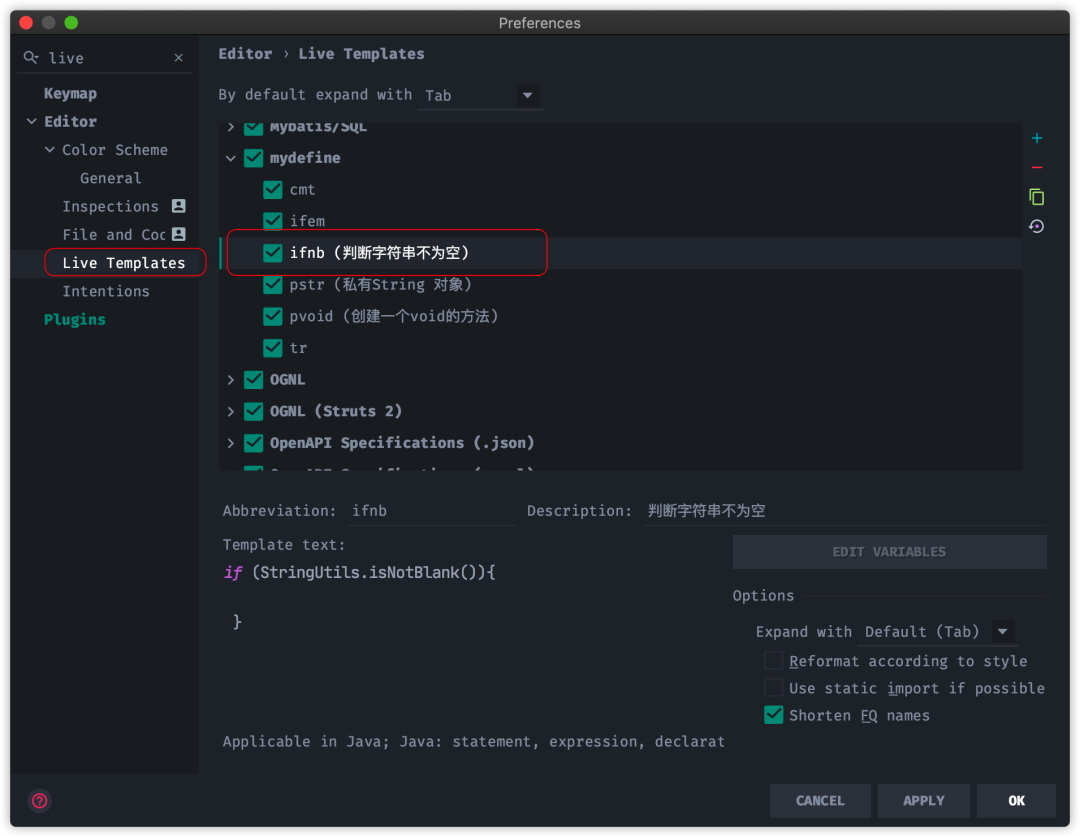head:
title: 我常用的开源工具类 shortTitle: 求求你了,不要再自己实现这些逻辑了,开源工具类不香吗? description: 文章比较长,希望大家看完有收获 author: 鸭血粉丝 category: - 微信公众号
head:
最近公司来了几个实习生,二哥负责带一个。这位小师弟说实话,基本功很扎实,做事也非常靠谱,深得二哥真传。
不过最近 Review 他代码的时候,二哥发现小师弟有些代码的逻辑繁琐,有些代码完全可以用一些开源工具类实现,会更优雅一些。
不过这也是正常的,二哥刚入行的时候写的代码也是这样,这几年慢慢接触了一些开源工具类,逐渐积累,现在写代码一般会直接用工具类替换自己实现的这些繁琐的逻辑。
今天就算是抛砖引玉,给球友们分享几个常用的工具类,希望能帮助到刚入行的球友。其他编程老司机如果还有其他好用的工具类,也欢迎分享出来。
今天主要分享的事字符串相关、日期相关、IO 相关、集合/数组相关和计时相关的工具类,后续持续更新。
一、字符串相关工具类
Java 中的 String 应该是日常用的最多一个类吧,平常我们很多代码需要围绕 String 做一些处理。
JDK 提供的 String API 虽然比较多,但是功能比较基础,通常我们需要结合 String 多写个方法才能完成一个业务功能。
下面介绍一下 Apache 提供的一个工具类 StringUtils.
Maven Pom 信息如下:
<dependency>
<groupId>org.apache.commons</groupId>
<artifactId>commons-lang3</artifactId>
<version>3.10</version>
</dependency>
commons-lang 有两个版本,一个是 commons-lang3 ,一个是 commons-lang。commons-lang 是老版本,已经很久没有维护了。commons-lang3 是一直在维护的版本,推荐直接使用这个版本。
判断字符串是否为空
判断字符串是否为空,估计大家都这么写过吧:
if (null == str || str.isEmpty()) {
}
虽然这段代码非常简单,但是说实话,很容易犯过空指针的异常。
使用 StringUtils,上面代码可以替换成下面这样:
if (StringUtils.isEmpty(str)) {
}
StringUtils 内部还有一个方法 isBlank,也是用来判断字符串是否为空,两个方法比较相近,容易搞混,主要区别如下:
// 如果字符串都是空格的话,
StringUtils.isBlank(" ") = true;
StringUtils.isEmpty(" ") = false;
判断字符串是否为空,使用频率非常高,这里大家可以使用 IDEA Prefix 的功能,输入直接生成判空语句。

字符串固定长度
这个通常用于字符串需要固定长度的场景,比如需要固定长度字符串作为流水号,若流水号长度不足,左边补 0 。
可以使用 String#format 方法,不过比较麻烦,这里可以使用:
// 字符串固定长度 8位,若不足,往左补 0
StringUtils.leftPad("test", 8, "0");
另外还有一个 StringUtils#rightPad,这个方法与上面方法正好相反。
字符串关键字替换
StringUtils 提供了一系列的方法,可以替换某些关键字:
// 默认替换所有关键字
StringUtils.replace("aba", "a", "z") = "zbz";
// 替换关键字,仅替换一次
StringUtils.replaceOnce("aba", "a", "z") = "zba";
// 使用正则表达式替换
StringUtils.replacePattern("ABCabc123", "[^A-Z0-9]+", "") = "ABC123";
....
字符串拼接
字符串拼接是个常见的需求,简单点可以使用 StringBuilder 循环遍历拼接:
String[] array = new String[]{"test", "1234", "5678"};
StringBuilder stringBuilder = new StringBuilder();
for (String s : array) {
stringBuilder.append(s).append(";");
}
// 防止最终拼接字符串为空
if (stringBuilder.length() > 0) {
stringBuilder.deleteCharAt(stringBuilder.length() - 1);
}
System.out.println(stringBuilder.toString());
不过这样的太不太优雅,也很容易抛出 StringIndexOutOfBoundsException。
这里我们可以直接使用以下方法拼接字符串:
StringUtils.join(["a", "b", "c"], ",") = "a,b,c"
StringUtils 只能传入数组拼接字符串(),不过我比较喜欢集合拼接,所以再推荐下 Guava 的 Joiner。
实例代码如下:
String[] array = new String[]{"test", "1234", "5678"};
List<String> list=new ArrayList<>();
list.add("test");
list.add("1234");
list.add("5678");
StringUtils.join(array, ",");
// 逗号分隔符,跳过 null
Joiner joiner=Joiner.on(",").skipNulls();
joiner.join(array);
joiner.join(list);
关于字符串拼接内部的工作原理,可以参考《Java 程序员进阶之路》上的帖子:
字符串拆分
有字符串拼接,就会有拆分字符串的需求,同样的 StringUtils 也有拆分字符串的方法。
StringUtils.split("a..b.c", '.') = ["a", "b", "c"]
StringUtils.splitByWholeSeparatorPreserveAllTokens("a..b.c", ".")= ["a","", "b", "c"]
ps:注意以上两个方法区别。
StringUtils 拆分之后得到的是一个数组,我们也可以使用 Guava 中的方法:
Splitter splitter = Splitter.on(",");
// 返回是一个 List 集合,结果:[ab, , b, c]
splitter.splitToList("ab,,b,c");
// 忽略空字符串,输出结果 [ab, b, c]
splitter.omitEmptyStrings().splitToList("ab,,b,c")
StringUtils 内部还有其他常用的方法,小伙伴可以自行查看其 API。
关于字符串拆分内部的工作原理,可以参考《Java 程序员进阶之路》上的帖子:
二、日期相关工具类
DateUtils/DateFormatUtils
JDK8 之前,Java 只提供一个 Date 类,平常我们需要将 Date 按照一定格式转化成字符串,我们需要使用 SimpleDateFormat。
SimpleDateFormat simpleDateFormat=new SimpleDateFormat("yyyy-MM-dd HH:mm:ss");
// Date 转 字符串
simpleDateFormat.format(new Date());
// 字符串 转 Date
simpleDateFormat.parse("2020-05-07 22:00:00");
代码虽然简单,但是这里需要注意 SimpleDateFormat,不是线程安全的,多线程环境一定要注意使用安全。
这里二哥推荐 commons-lang3 下的时间工具类DateUtils/DateFormatUtils 解决 Date 与字符串转化问题。
使用方法非常简单:
// Date 转化为字符串
DateFormatUtils.format(new Date(),"yyyy-MM-dd HH:mm:ss");
// 字符串 转 Date
DateUtils.parseDate("2022-11-02 22:00:00","yyyy-MM-dd HH:mm:ss");
除了格式转化之外,DateUtils 还提供时间计算的相关功能。
Date now = new Date();
// Date 加 1 天
Date addDays = DateUtils.addDays(now, 1);
// Date 加 33 分钟
Date addMinutes = DateUtils.addMinutes(now, 33);
// Date 减去 233 秒
Date addSeconds = DateUtils.addSeconds(now, -233);
// 判断是否 Wie 同一天
boolean sameDay = DateUtils.isSameDay(addDays, addMinutes);
// 过滤时分秒,若 now 为 2022-11-02 22:13:00 调用 truncate 方法以后
// 返回时间为 2022-11-02 00:00:00
Date truncate = DateUtils.truncate(now, Calendar.DATE);
JDK8 时间类
JDK8 之后,Java 将日期与时间分为 LocalDate,LocalTime,功能定义更加清晰,当然其也提供一个 LocalDateTime,包含日期与时间。这些类相对于 Date 类优点在于,这些类与 String 类一样都是不变类型,不但线程安全,而且不能修改。
ps:仔细对比 MySQL 时间日期类型
DATE,TIME,DATETIME,有没有感觉差不多?
现在 MyBatis 等 ORM 框架已经支持 LocalDate 与 JDBC 时间类型转化,所以大家可以直接将时间字段实际类型定义为 JDK8 时间类型,然后再进行相关转化。
如果依然使用的是 Date 类型,需要相关转化,稍微复杂一点。
Date now = new Date();
// Date-----> LocalDateTime 这里指定使用当前系统默认时区
LocalDateTime localDateTime = now.toInstant().atZone(ZoneId.systemDefault()).toLocalDateTime();
// LocalDateTime------> Date 这里指定使用当前系统默认时区
Date date = Date.from(localDateTime.atZone(ZoneId.systemDefault()).toInstant());
接下来我们使用 LocalDateTime 进行字符串格式化。
// 按照 yyyy-MM-dd HH:mm:ss 转化时间
LocalDateTime dateTime = LocalDateTime.parse("2022-11-02 22:34:00", DateTimeFormatter.ofPattern("yyyy-MM-dd HH:mm:ss"));
// 将 LocalDateTime 格式化字符串
String format = DateTimeFormatter.ofPattern("yyyy-MM-dd HH:mm:ss").format(dateTime);
另外我们使用 LocalDateTime 获取当前时间年份,月份特别简单:
LocalDateTime now = LocalDateTime.now();
// 年
int year = now.getYear();
// 月
int month = now.getMonthValue();
// 日
int day = now.getDayOfMonth();
最后我们还可以使用 LocalDateTime 进行日期加减,获取下一天的时间:
LocalDateTime now = LocalDateTime.now();
// 当前时间加一天
LocalDateTime plusDays = now.plusDays(1l);
// 当前时间减一个小时
LocalDateTime minusHours = now.minusHours(1l);
// 还有很多其他方法
总之 JDK8 提供的时间类非常好用,还没用过的球友,可以尝试下。
三、集合/数组相关
集合与数组也经常使用,也需要对其进行判空:
if (null == list || list.isEmpty()) {
}
ps: 数组、Map、集合类似
上面的代码和字符串判空一样写起来都非常简单,但是都比较容易抛出空指针异常。这里我们可以使用 commons-collections 提供工具类。
pom 信息:
<dependency>
<groupId>org.apache.commons</groupId>
<artifactId>commons-collections4</artifactId>
<version>4.4</vesion>
</dependency>
可以使用 CollectionUtils/MapUtils进行判空判断。
// List/Set 集合判空
if(CollectionUtils.isEmpty(list)){
}
// Map 等集合进行判空
if (MapUtils.isEmpty(map)) {
}
至于数组判空判断需要使用 commons-lang 下的 ArrayUtils进行判断:
// 数组判空
if (ArrayUtils.isEmpty(array)) {
}
除此之外还有一些列的对于集合增强方法,比如快速将数组加入到现有集合中:
List<String> listA = new ArrayList<>();
listA.add("1");
listA.add("2");
listA.add("3");
String[] arrays = new String[]{"a", "b", "c"};
CollectionUtils.addAll(listA, arrays);
四、I/O 相关
JDK 提供了一系列的类用于读写文件,不过二哥觉得那些类有些晦涩难懂,实现一个小功能可能要写好多代码,而且还不一定能写对。
这里推荐一下 Apache 提供的 commons-io 库,增强 I/O 操作,简化操作难度。pom 信息:
<dependency>
<groupId>commons-io</groupId>
<artifactId>commons-io</artifactId>
<version>2.6</version>
</dependency>
FileUtils-文件操作工具类
文件操作工具类提供一系列方法,可以让我们快速读写文件。
快速实现文件/文件夹拷贝操作,FileUtils.copyDirectory/FileUtils.copyFile
// 拷贝文件
File fileA = new File("E:\\test\\test.txt");
File fileB = new File("E:\\test1\\test.txt");
FileUtils.copyFile(fileA,fileB);
使用 FileUtils.listFiles 获取指定文件夹上所有文件
// 按照指定文件后缀如java,txt等去查找指定文件夹的文件
File directory = new File("E:\\test");
FileUtils.listFiles(directory, new String[]{"txt"}, false);
使用 FileUtils.readLines 读取该文件所有行。
// 读取指定文件所有行 不需要使用 while 循环读取流了
List<String> lines = FileUtils.readLines(fileA)
有读就存在写,可以使用 FileUtils.writeLines,直接将集合中数据,一行行写入文本。
// 可以一行行写入文本
List<String> lines = new ArrayList<>();
.....
FileUtils.writeLines(lines)
IOUtils-I/O 操作相关工具类
FileUtils 主要针对相关文件操作,IOUtils 更加针对底层 I/O,可以快速读取 InputStream。实际上 FileUtils 底层操作依赖就是 IOUtils。
来看支付场景下,我们使用 JDK 原生方法是如何获取 HTTP 异步通知的:
byte[] b = null;
ByteArrayOutputStream baos = null;
String respMsg = null;
try {
byte[] buffer = new byte[1024];
baos = new ByteArrayOutputStream();
// 获取输入流
InputStream in = request.getInputStream();
for (int len = 0; (len = in.read(buffer)) > 0; ) {
baos.write(buffer, 0, len);
}
b = baos.toByteArray();
baos.close();
// 字节数组转化成字符串
String reqMessage = new String(b, "utf-8");
} catch (IOException e) {
} finally {
if (baos != null) {
try {
baos.close();
} catch (IOException e) {
}
}
}
上面代码看起来还是挺复杂的。不过我们可以使用 IOUtils,一个方法就可以简单搞定:
// 将输入流信息全部输出到字节数组中
byte[] b = IOUtils.toByteArray(request.getInputStream());
// 将输入流信息转化为字符串
String resMsg = IOUtils.toString(request.getInputStream());
ps: InputStream 不能被重复读取
五、计时
编程中有时需要统计代码的的执行耗时,代码非常简单,结束时间与开始时间相减即可。
long start = System.currentTimeMillis(); //获取开始时间
//其他代码
//...
long end = System.currentTimeMillis(); //获取结束时间
System.out.println("程序运行时间: " + (end - start) + "ms");
虽然代码很简单,但是非常不灵活,默认情况我们只能获取 ms 单位,如果需要转换为秒/分钟,就需要另外再计算。
这里介绍一下 Guava 的 Stopwatch 计时工具类,借助他统计程序执行时间,使用方式非常灵活。
commons-lang3 与 Spring-core 也有这个工具类,使用方式大同小异,大家根据情况选择。
// 创建之后立刻计时,若想主动开始计时
Stopwatch stopwatch = Stopwatch.createStarted();
// 创建计时器,但是需要主动调用 start 方法开始计时
// Stopwatch stopwatch = Stopwatch.createUnstarted();
// stopWatch.start();
// 模拟其他代码耗时
TimeUnit.SECONDS.sleep(2l);
// 当前已经消耗的时间
System.out.println(stopwatch.elapsed(TimeUnit.SECONDS));;
TimeUnit.SECONDS.sleep(2l);
// 停止计时 未开始的计时器调用 stop 将会抛错 IllegalStateException
stopwatch.stop();
// 再次统计总耗时
System.out.println(stopwatch.elapsed(TimeUnit.SECONDS));;
// 重新开始,将会在原来时间基础计算,若想重新从 0开始计算,需要调用 stopwatch.reset()
stopwatch.start();
TimeUnit.SECONDS.sleep(2l);
System.out.println(stopwatch.elapsed(TimeUnit.SECONDS));
输出结果为:
2
4
6
总结
今天就权当抛砖引玉,介绍了字符串、日期、数组/集合、I/O、计时等工具类,简化日常业务代码。后续会持续补充,大家在日常开发中也要注意积累自己的工具类,方便后面用到的时候可以不用重复造轮子。
当然了,对于工具类,最好不要只停留在会用的层面上,还是要去看它的内部实现,那里面才是编程的精华,很能提升我们的代码能力。
参考链接:https://mp.weixin.qq.com/s?__biz=MzkzODE3OTI0Ng==&mid=2247490962&idx=1&sn=10856b0360f777bdf6c1e9c2adf3cdef&source=41#wechat_redirect,出处:Java 极客技术,整理:沉默王二